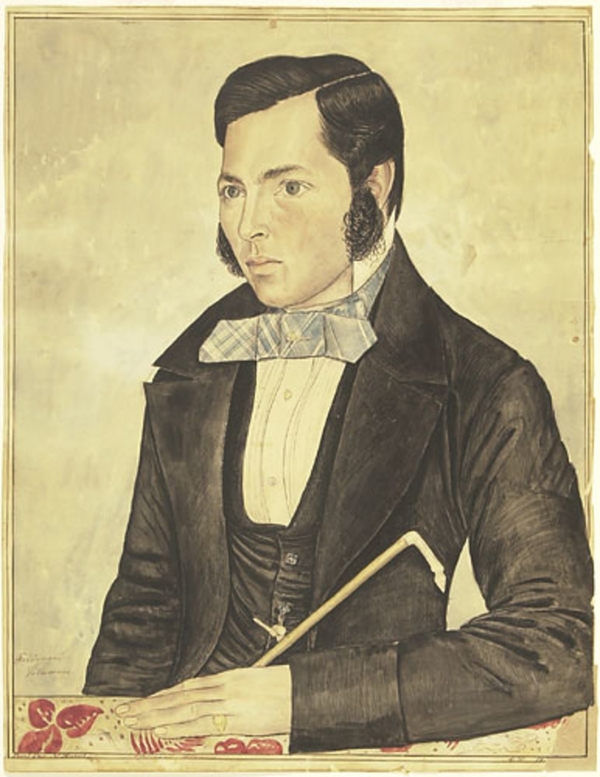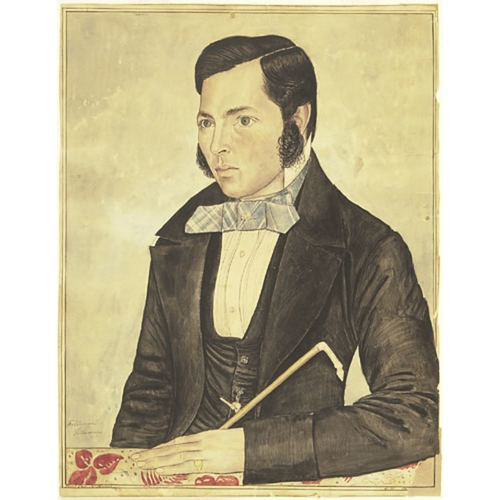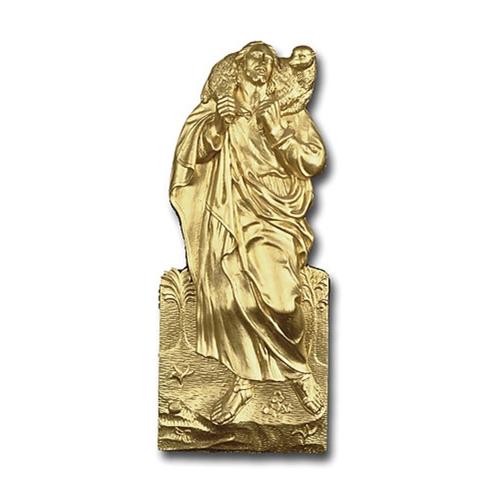
Source: Link
VILLENEUVE, FERDINAND, architect, woodcarver, cabinet-maker, and contractor; b. 7 Dec. 1831 in Charlesbourg, Lower Canada, son of Thomas Villeneuve, a farmer, and Luce Cauchon; m. 25 Jan. 1859 Odile Morin in the parish of Saint-Isidore at Lauzon (Lévis), and they had nine children; d. 4 Sept. 1909 in Saint-Romuald, Que.
Ferdinand Villeneuve was 15 when in January 1847 his father placed him as an apprentice in the workshop of master wood-carver André-Raphaël Giroux*, which was then at Quebec. The training he received over a six-year period linked him with what is known as the Quebec school, a line of artists who had been influenced by Thomas Baillairgé*, and it profoundly marked his work.
Late in 1852 or early in 1853 Villeneuve opened his own atelier in the city; on 15 June 1855 he bought a house on Rue Richardson (De La Salle), in the Saint-Roch quarter. He worked for himself as well as on Giroux’s numerous projects, in particular, in the period 1854–57, on the carving for the interior of Notre-Dame-des-Victoires church at Quebec. Shortly after his marriage he set up shop in Saint-Isidore, where he had just obtained a big subcontract to decorate the parish church. Engaged as a woodcarver by master joiners Jean-Baptiste Saint-Michel and Louis Patry from 1858 to 1868, he was called upon to design and execute all the interior ornamentation and the liturgical furnishings for the church, in particular the retables (the structures housing the altars) in the sanctuary and chapels, and the high altar, side altars, pulpit, churchwardens’ pew, and baptismal font. Inspired by the church in Saint-Anselme and Corinthian in conception, the design of the vaulting and retables brings to mind the finest decorative ensembles of Baillairgé and his disciples; likewise, the furnishings were in keeping with Baillairgé’s aesthetics. At the end of this period, in 1867 and 1868, Villeneuve also described himself as a farmer.
By December 1868 Villeneuve was at Saint-Romuald, where he had opened a small shop. The rest of his life would be spent in this village on the south shore of the St Lawrence, not far from Quebec. There, from 1869 to 1873, he acquired various properties and houses through lease or purchase. Most important of all, he set up a workshop that specialized in designing, decorating, and furnishing churches. He hired several assistants; at the time he moved in, he had in his employ cabinet-maker Louis Saint-Hilaire, dit Pichette. In the mid 1870s there were also some apprentices, among them his second son, Joseph, as well as Joseph Saint-Hilaire, the son of Louis, and Joseph Gagnon. By 1879 he had acquired some social status and was elected mayor of his adopted parish.
Villeneuve’s first ten years in Saint-Romuald were not only the most active of his career, they also largely established his reputation in the fields of architecture and wood-carving. At the Quebec provincial exhibition in September 1871 his carvings, in particular a statue of the Good Shepherd, attracted a great deal of attention from the experts and newspaper columnists, and he received a first prize awarded specially for “pots of flowers in wood.” In the following years, because of the unexpected boost the fair gave his career, the architect and wood-carver, who now headed a large workshop with a number of employees, carried out many contracts for churches in the region around Quebec City.
At the very beginning of the 1870s, Villeneuve, it seems, executed the high altar of the church at Les Écureuils (Donnacona), which was embellished with a statue of the Good Shepherd, as well as the altar of St Joseph in Notre-Dame cathedral in Quebec. In 1872 the churchwardens of Saint-Nicolas commissioned him to design the interior decoration of the parish church and do the restoration, comprising work to “repair the wood vaulting, level it up over the chancel and chapels, raise, panel, and carve the chancel, redo the retables, reinforce the flooring, put in two doorways in the chapels, [and] make three new altars.” The same year he was entrusted with decorating the chapel in Saint-Roch church at Quebec according to his drawings, for the sum of $2,000, and also with executing the altar of the Sacred Heart. The work, completed with statues of St Anne and the Virgin, brought him praise in the city’s newspapers. In 1873 he did the side altars in the same church.
A short time later Villeneuve, with the help of Louis Saint-Hilaire, worked on the three altars in the church at Saint-Romuald, using drawings by a Munich architect named Schneider, as well as on the pulpit. Late in 1874 he contracted to build an imposing high altar for the parish church of Saint-Joseph in Lauzon. Its retable with a tabernacle, inspired by a Schneider drawing in Byzantine style, comprised seven statuettes and a relief of the Good Shepherd; however, “in order not to destroy the architectural harmony of the church,” Villeneuve, “depart[ing] from the style generally adopted in all churches,” chose the Corinthian order. This work received the greatest praise; Le Courrier du Canada averred that he was “indisputably the wood-carver most in demand” in the region. In 1875 he also supervised the restoration of the chapel for the Congrégation des Hommes in Saint-Roch parish at Quebec, a major project that cost $3,000.
In 1876–77, besides building the organ-case and confessionals for the new church in Sainte-Anne-de-Beaupré and receiving a contract to do the false vault for the church of Saint-Henri at Lévis, Villeneuve carved the main altar for the church in Saint-Anselme following his own drawings, which were inspired by the Corinthian order. This work was again a success; he also did two niches and, possibly, a side altar for the church. In 1877 he delivered two side altars, which had been designed by David Ouellet*, to the church of Saint-Simon-de-Rimouski. In addition during this period he appears to have executed some work for Notre-Dame-de-Pitié chapel in Notre-Dame de Lévis church. It is known that in 1878 he built the main altar, from his own drawings, for the church of Saint-Sauveur at Quebec and did all the interior decoration and the high altar for Sacré-Cœur chapel, which was next door to the Couvent Jésus-Marie at Lauzon; the altar, done in the Corinthian style, once more brought him praise in the press.
With the 1880s a new stage in Villeneuve’s career began. Joseph Saint-Hilaire finished his apprenticeship in 1880 and went to work with David Ouellet and François-Xavier Berlinguet* at Quebec. When he opened his own workshop in Saint-Romuald three years later, he entered into direct competition with his former employer, whose pace of activity was already slowing somewhat despite his advertisements in the newspapers. In the 1880s and 1890s Villeneuve consolidated his financial position by speculating in land at Saint-Romuald.
In 1880–81 Villeneuve was involved in restoring the church of Saint-Simon-de-Rimouski and its sacristy. Between 1882 and 1887 he did a good deal of cabinet-making and painting at the school run by the Frères de la Doctrine Chrétienne and at the church and presbytery in Saint-Romuald. The fabrique of the church of Saint-François (at Beauceville) in 1887 awarded him a contract for $1,800 to make three altars and build galleries and a second rood-loft. In 1891 he carved the altars, pulpit, and sounding-board, from plans drawn by Georges-Émile Tanguay*, for the church of Saint-Médard in Warwick. At about the same period he was commissioned to do the pulpit for the church at Pointe-Gatineau (Gatineau). In 1894 he submitted a tender and received the contract to make the high altar, from a design by Ouellet, for the church at Saint-Michel in Bellechasse County, on condition that the statues involved be done by Louis Jobin*; he also signed an estimate for decorating the chancel. The following year he did work for the parish of Saint-Elzéar in the Beauce and possibly on the decoration of the sanctuary in Notre-Dame de Lévis, as well as on the tabernacle of the church in Chicoutimi following plans drawn by Joseph-Ferdinand Peachy and David Dussault.
From the 1890s Villeneuve seems more and more to have shared the contracts awarded his workshop in Saint-Romuald with his son Joseph, and he left him an increasing role in running the family business. As shop manager, he kept for himself the tasks of designing and drafting projects and supervising sites. He is not known, however, to have undertaken anything in his own name during the second half of the decade. Furthermore, from 1898 he described himself as a person of independent means as well as a contractor. It was in this period that he seems finally to have handed management of the workshop over to his son, who founded the Compagme de Bois Manufacturé, from 1907 the Compagnie Jos. Villeneuve Limitée.
The enterprise had up to a score of employees and also passed on special orders to subcontractors such as sculptor Louis Jobin. For some time a good many workmen – cabinet-makers or journeymen – clustered around Ferdinand or Joseph; in addition they had attracted carvers Philippe Roberge, Alyre Prévost, Edmond Patry, and Lauréat Vallière, who began his apprenticeship with Joseph in 1903. Inside the factory, production was organized and tasks divided largely along industrial lines. The firm occupied a three-storey building. Sawing, planing, and glueing the wood (which was done right beside the boiler-room) took up the first floor; the shops for drafting, joining, and wood-carving were on the second; the third floor was reserved for finishing (painting, gilding, and varnishing). Around 1900 the orders were flooding in and the firm was working to capacity. At that time Joseph was engaged in numerous jobs, doing decorating and liturgical furnishings for churches including those of Sainte-Anne-de Chicoutimi-Nord (Chicoutimi), Saint-François on the Île d’Orléans, Saint-Odilon in Cranbourne Township, Notre-Dame-de-l’Immaculée at Notre-Dame-de-Laterrière (Laterrière), Saint-Ambroise (in Loretteville), and Saint-Isidore, the church where his father had begun his career. In 1901 he exhibited an altar at the Quebec provincial exhibition and won a gold medal.
By the end of his life Ferdinand Villeneuve was very well-off. In addition to the supplies and equipment in the workshop, he owned, among other things, landed property, ground-rents, and various stocks, which his sons Joseph and Alphonse (a doctor) inherited in 1909.
Villeneuve’s workshop shows in its structure and functioning the changes that affected wood-carving and craftsmen’s practices in the last quarter of the 19th century. These changes were clearly related to industrialization, in particular to the change-over from shop to factory. In this pre-industrial period in wood-carving, the various stages in the conception and execution of decorating projects, which were similar to assembly-line tasks, were increasingly based on a division of work among specialized third parties.
Trained initially as a cabinet-maker and woodcarver, Villeneuve, like Berlinguet and Ouellet, gradually became an architect and contractor. He then ran a mechanized and highly organized shop with a clear division of tasks among workmen (machine operators and turners), and cabinet-makers and wood-carvers proper. As a general contractor and prosperous entrepreneur, he took on all sorts of projects and often confined himself to supervising the sites, letting independent craftsmen execute retables, furnishings, decorations, statues, and storiated reliefs. The commissioning, conception, and execution of certain decorative undertakings – such as the high altar in Saint-Michel – illustrate well the multiple and complex relations between the client, the architect-designer, the contractor, and the subcontractors. By the end of the 19th century this sort of collaboration and complementarity had become common practice in large-scale projects. According to his contemporaries, Villeneuve was recognized not only for his great qualities as shop manager and for his business sense as an entrepreneur, but also for his talent as an architect and wood-carver. He was capable of drawing up the plans and estimates for interior decorations and furnishings himself, and on occasion he even took the liberty of interpreting designs from other architects, in particular those by Schneider.
Many of Villeneuve’s projects carried on the great aesthetic tradition recommended by Baillairgé: neoclassicism drawn from the Louis XVI style. These decorative works, which had been conceived as a harmonious whole, were characterized by retables with Corinthian columns arranged in a semicircle or as a triumphal arch. All the carved parts were subjected to a strict architectural disposition. Just like Berlinguet, however, Villeneuve distanced himself from the principles advanced by Baillairgé’s disciples. He appreciated eclectic architecture and the “revival” styles and exploited with a certain rigour the possibilities of monumental neoclassicism. His colossal retable-tabernacles, for instance at Lauzon and Saint-Anselme, were thus designed to give prominence to the high altar. The ensembles done according to the Corinthian order, which “demand[ed] a great wealth of decoration,” such as the one at Lauzon, furthered the decline in representational carving and the promotion of decorative carving with trophies, baskets or bouquets of flowers, ears of wheat, grape or acanthus leaves, bunches of grapes, and cornucopias, among other things. In this respect Villeneuve was famous as a wood-carver specializing in ornamentation. On the other hand, his retables and articles of furniture are devoid of figurative reliefs, except for a few representations of the Good Shepherd on the monstrances of his tabernacles. These dynamic and powerful works, all inspired by the same model, give proof of a sure talent and a mastery of the craft. He is also credited with a number of statues – in particular on the altars at Saint-Isidore, Saint-Roch, and Lauzon – said by newspapers of the period to reveal “a superior talent in the art of statuary.” But according to some of his contemporaries, Villeneuve never carved any statues, generally leaving such commissions to Jobin.
Ferdinand Villeneuve’s career and work belong to the period that witnessed the coming together of two great schools of architect-wood-carvers: the Quebec school, in which he had been trained, and the Saint-Romuald school, of which he was the originator. Despite ups and downs the Compagnie Jos. Villeneuve Limitée would carry on in decoration and furnishings until the middle of the 20th century. As a 1929 advertisement in the Album des églises de la province de Québec (Montréal) indicates, the firm had completed numerous major projects in churches, convents, and colleges, not only in Quebec but also in other Canadian provinces and even south of the border. For a time the little village had four woodcarving shops that employed nearly 100 men and distributed their products throughout Canada and in parts of the United States.
In addition to the archives of most of the parishes mentioned in Villeneuve’s biography, the following notarial minute-books were consulted: AC, Arthabaska, Minutiers, Léonidas Laliberté, 15 mars 1869–15 févr. 1870; Beauce (Saint-Joseph-de-Beauce), Minutiers, Philippe Angers, 23 janv. 1887, and J.-H. Reny, 22 janv. 1859; Québec, Minutiers, E.-J. Angers, 19 nov. 1898; H. C. Austin, 13 mai 1872; Joseph Boutin, dit Bourassa, 14 févr. 1881–15 juin 1910; Joseph Lagueux, 19 sept. 1901; M.-N.-D. Légaré, 9 oct. 1883; J.-T. Lemieux, 15 févr. 1897–2 avril 1909; and Étienne Simard, 26 août 1867, 14 nov. 1873; Trois-Rivières, Minutiers, E.-H. Tremblay, 24 nov. 1874, 3 mai 1875. The other principle sources of information follow.
AC, Québec, État civil, Catholiques, Saint-Romuald (Saint-Romuald), 7 sept. 1909. ANQ-Q, CE1–7, 8 déc. 1831; CE6–18, 25 janv. 1859; CN1–19, 5 avril 1869; CN1-85, 15 févr. 1871; CN1–113, 18 oct. 1875; CN1–128, 11 oct. 1861; CN1–181, ler mai 1883; CN1–216, 15 juin 1855–17 nov. 1856; CN1–255, 12 févr. 1847; T11–1/4321, 19 avril 1869; 4324, 9 févr. 1881; 4513. AUL, P175, plans de Joseph Villeneuve. Canadian Museum of Civilization (Hull, Que.), Coll. Marius Barbeau, maîtres-sculpteurs, dossier 60. Musée du Québec (Québec), Dossier de Ferdinand Villeneuve; Dossier des œuvres de la coll.; Fonds Gérard-Morisset, dossiers Ferdinand Villeneuve, Joseph Villeneuve, et Joseph Saint-Hilaire; dossiers paroisses. Qué., Ministère des Affaires Culturelles, Centre de Documentation (Québec), Dossiers de paroisses. Le Courrier du Canada, novembre 1875, avril-juin 1880, 5 août 1891, 15 sept. 1894. L’Électeur, 18 sept. 1894, 10 oct. 1895. L’Événement, 13 sept. 1871; 9 avril 1875; 23 août 1877; 11, 14 sept. 1894. Le Journal de Québec, septembre 1871-mars 1873, avril 1875-novembre 1876, 27 avril 1878, avril-septembre 1880, 26 avril 1883. Le Quotidien du Saguenay-Lac-Saint-Jean (Chicoutimi, Qué.), 3 mars 1981: Al; 5 mars 1981: A6. Le Soleil, 14 sept. 1901: 2. Mario Béland, “Ferdinand Villeneuve (1831–1909), architecte et sculpteur,” Espace (Montréal), 7 (1990–91), no.3: 7–9; “Louis Jobin (1845–1928) et le marché de la sculpture au Québec” (thèse de phd, univ. Laval, 1991). Léopold Désy, Lauréat Vallière et l’école de sculpture de Saint-Romuald, 1852–1973 (Sainte-Foy, Qué., 1983). Directory, Quebec, 1847–60. J. R. Porter et Jean Bélisle, la sculpture ancienne au Québec; trois siècles d’art religieux et profane (Montréal, 1986).
Cite This Article
Mario Béland, “VILLENEUVE, FERDINAND,” in Dictionary of Canadian Biography, vol. 13, University of Toronto/Université Laval, 2003–, accessed January 1, 2026, https://www.biographi.ca/en/bio/villeneuve_ferdinand_13E.html.
The citation above shows the format for footnotes and endnotes according to the Chicago manual of style (16th edition). Information to be used in other citation formats:
| Permalink: | https://www.biographi.ca/en/bio/villeneuve_ferdinand_13E.html |
| Author of Article: | Mario Béland |
| Title of Article: | VILLENEUVE, FERDINAND |
| Publication Name: | Dictionary of Canadian Biography, vol. 13 |
| Publisher: | University of Toronto/Université Laval |
| Year of publication: | 1994 |
| Year of revision: | 1994 |
| Access Date: | January 1, 2026 |




